By Pat Foster-Turley
January 13, 2023
Those of you fairly new to Nassau County maybe have not previously encountered a strong freeze lasting for a few days, and have not, until now, seen its aftermath. Looking around now, after the cold Christmastime weather, the results are evident. Dead or injured plants are everywhere!
My friend Susan Gallion sent me a couple of photos that really illustrate this. Like many others, she has planted and nurtured some tropical plants outdoors in her yard for many years, admiring their beauty and vigor. The ti and ginger plants in her front yard were magnificent. And then they weren’t. Her before and after photos show the devastation that a stretch of cold weather can do to tropical plants that evaded cold weather before. These plants are only adapted to warmer temperatures, such as we have had, uncharacteristically, for years until this “normal” cold snap hit us. Susan has been lucky for years. Some newcomers not so much. For months now I’ve been admiring the sea grape plants bordering a house on South Fletcher Avenue, noting that these normally are grown in south Florida. Before this I’ve never seen them planted here. Alas, they are no longer alive, out of their planting zone, and nature stepped in.


But there is hopefully a good side to these cold spells. Just maybe more than plants have been killed or set back. Unlike the tropical plants we may have mistakenly planted in our landscapes, other more warmer-climate organisms have made our place home. Exotic invasive species have taken advantage of our warming climate to join our regular native fauna and some of these are dangerous, if not fatal, to a number of our local animals.

Take the Cuban tree frogs for instance. These large light-colored frogs have invaded our yards in the past few years and recommendations are to kill them on sight, humanely of course. These frogs eat our native, much admired, green tree frogs and also many of the lizards that used to roam our yards. But now, on the Facebook site “Frogs and Toads of Florida” there are a number of photos of dead or dying Cuban tree frogs. And, believe it or not, that’s a good thing. Just maybe they will be gone from our area at least for a while and the native green tree frog populations can rebound.
Another especially malicious species, the hammerhead worm, has recently entered our area from Southeast Asia, maybe through the horticulture trade. This worm is not an annelid like our earthworms but instead is a terrestrial planarian, a strange creature that is sometimes said to be “immortal” since even tiny pieces of one that is cut up will regenerate into a complete new individual. Like the exotic invasive frogs, these invasive worms are a threat to our natural ecosystems. They eat the earthworms that fulfill a necessary ecological role by aerating and fertilizing our soil and eat insect larvae and other prey as well. And, like the Cuban tree frog, they also secrete a poison, in this case a tetrodotoxin that is also found in the poisonous pufferfish. Similarly to the Cuban tree frog, the recommendations are to humanely kill them (although no one has specified how.) But now, hopefully many of these have also been killed by our recent cold temperatures, well below the warmer climate they thrive in.

And, one can only hope that another exotic invasive species, the crazy ants, will also succumb to the recent cold temperatures. These ants don’t bite people and no one has reported on their impact on local ecosystems, but anyone who has encountered them can attest to their nuisance value. Many homeowners this past summer were overwhelmed by the hordes of these tiny ants in their yard and decks. They swarm seemingly aimlessly around (“crazy”) in masses and climb up your legs whenever you stop moving. For a while it was nearly impossible to walk on the south end of the Egan’s Creek Greenway due to these ants mobbing you and coating your legs with moving black masses. Like the hammerhead worms, these ants most likely originated in Southeast Asia and got here through global shipping routes.
Only time will tell if this recent cold spell has for now killed off these Cuban tree frogs, hammerhead worms and crazy ants as well as other warm-temperature exotic invasives in our area. Let’s hope we see the last of these noxious species, at least for a while. But mark my words, they will be back.
Pat Foster-Turley, Ph.D., is a zoologist on Amelia Island. She welcomes your nature questions and observations. [email protected]

Very informative article….article RATING on page did not work…would have been s 5!
Thanks for another great article.
Thanks for an informative article. One takeaway is to plant native species only – they will survive better, they will nourish the local and migrating birds and butterflies with which they evolved, and they will enhance the soil. Avoid the box stores and buy from local nurseries that stock native plants. Contact UF Nassau County Extension for great advice!
Thanks Pat!
Spoiled by the Grand Solar maximum which ended in 2020, the earth will cool for the next 50yrs or so. The weak magnetic field of the sun will allow more cosmic rays into our solar system which will increase frequency and intensity of storms. Plant accordingly.